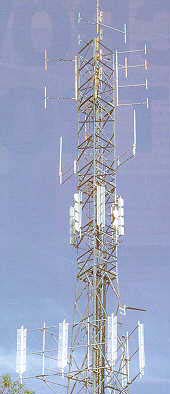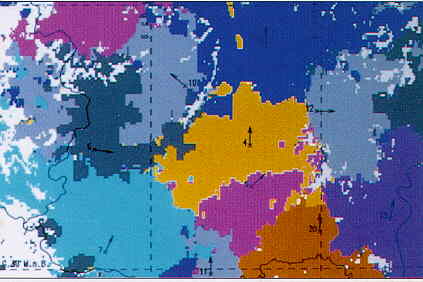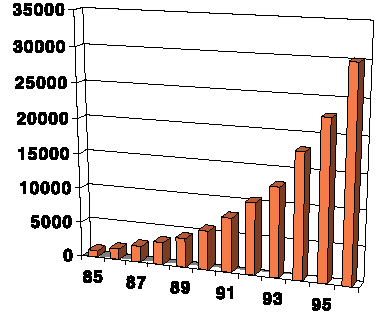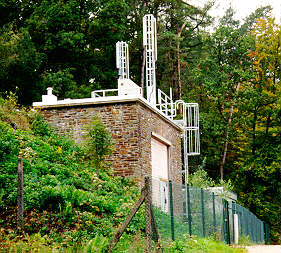
 |
JPL's Wireless Communication Reference WebsiteChapter: Cellular Telephone Networks. |

| In the practice of cell planning, cells are not hexagonal
as considered in the theoretical studies. Computer methods are being used
for optimized planning of base station locations and cell frequencies. Pathloss
and link budgets are computed from the terrain
features and antenna data. This determines to coverage of each base station
and interference to other cells.
Prediction of coverage using topological databases is often possibly with an accuracy (standard deviation) of about 6 to 8 dB. Standard deviations of 3 or 4 dB in the predication error appear out of reach. |
 Source: Siemens TORNADO D Cellular Planning Tool |
By May 1997, Mannesmann Mobilfunk operated about 5,500 base stations to cover Germany (80 Million inhabitants). The network has been growing over time and continues to grow in order to increase coverage and to enhance capacity in dense areas. Frequency planning has to adapt continuously to new base stations being added and changing traffic intensities. Cell sizes are far from homogeneous. City centers are covered by small cells, whereas in rural areas cell are much larger.
In a country like The Netherlands, densely populated with about 15 Million inhabitants in relatively flat terrian, each of the five GSM operators needs about 1,500 to 2,500 base station sites. Cell radii are about 6 km. Site sharing has been made mandatory by law, to avoid excessive growth of the number of sites. Church towers are often used to carry antennas. Operators pay a rent of typically 2,000 to 5,000 USD per year for a site. The installation of a base station costs about 150,000 to 250,000 USD. Second largest, but rapidly growing operator Libertel invested 300,000,000 USD in their infrastructure over 1999 to support calls from their 2 Million subscribers and pre-paid callers.

| Number of Cell sites in the US
A 25 % growth per year creates an attractive market for infrastructure vendors. Acquisition of new sites is a major effort for operators. Rapid roll-out determines their ability to attract new subscribers. |
Coverage or Capacity Planning?
Disclaimer: Executable software programs are provided with no guarantee whatsoever. See License.
An important aspect is the distribution of traffic. Cell sizes need to be smaller in areas with more traffic. The erlang theory addresses the amount of traffic that can be carried over a given number of channels, at a given blocking rate. If a GSM operator faces blocking rates that are two large in a certabin area, he could for instance
The first option is more efficient from a frequency scarcity point of view. In both cells, the 8 channels can carry 3.13 erlang at a blocking rate of 1%. In the second case, the 16 channels can carry 8.8 erlang at 1% blocking. Note that this is signifacantly more than 2 times 3.13 erlang. (check for yourself.)

The path loss law determines how dense frequencies can be reused. Moreover, terrain irregularities may shield radio signals, and can thus be exploited to ensure little interference among cells.